|
Product Review |

|
| By Bob Throne - Willow Grove,
Pennsylbania - USA |
System Three Silvertip
GelMagic
I had put up a 12’ x 20’ screen
room to serve as a boat shop, constructed
a strong back, bought a pile of plywood, and begun
to measure and cut out bulkheads … so it was
time to purchase some adhesive. About this time Chuck
and Sandra added Gel
Magic to their line and it seemed like
the right thing to use. A day after I ordered I got
a confirmation from Sandra, a couple of days after
that and UPS dropped it off at my home, and the next
day after that Chuck sent me note asking me for a
short product review.
After all the help folks on Duckworks have given
me designing my 15’ Pocket Cruiser “Wanderer”,
how could I refuse. Except. The good news is that
I’ve never built a boat before so I have no
preconceived notions to bias my opinions. The bad
news is that I’ve never built a boat before
so I have no preconceived notions to bias my opinions
.. or experience to compare with. I am, however, a
life-long builder of radio-controlled model airplanes
and I’ve been using epoxy since it first became
available, albeit in much smaller proportions. And
among other things that I knew was that most epoxies
are “runny” .. not quite water-like, but
pretty thin. The thicker viscosity purported with
Gel Magic appealed to me. It was time to give it a
try.
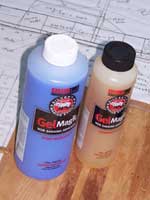 |
This is
what it looks like in the bottle.
(click
images to enlarge) |
|
| This is what
comes out. |
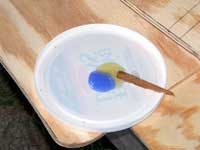
|
|
The correct ratio is two parts resin to one part
hardener .. And that raises the first point about
using GelMagic. The resin is VERY thick and pours
VERY slowly and settles very slowly into the mixing
cup. The hardener is much thinner, about what I’ve
experienced with other brands so it is easy to pour
too much. A well marked cup will help, but it takes
attention. Happily, I see no real difference in results
in the batches where I used too much hardener.
The second point is so common that I might not have
mentioned it. It is easy to mix too much at first,
until you learn to judge how much you need for each
joint. Here are a couple of shots that illustrate
my first tries:
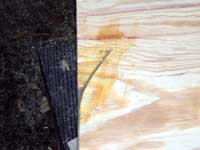 |
The first
shows GelMagic used to fill an errant
saw cut.
|
|
It filled just fine - Thick enough to fill that
3/16” gap without running.
| The next shot
shows what it looks like a half hour after
mixing too large a batch (on the right).
|

|
|
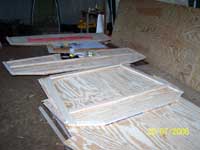 |
The third
shot shows the bulkheads ready to glue...
|
|
| ... and the
fourth after they’re done. |
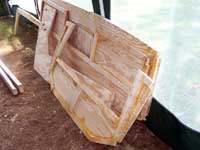
|
|
With latex gloves on and working with the epoxy,
I didn’t take any close ups of the joining process
itself, but it’s pretty straight forward to
mix a batch, spread it on the parts and put them together.
I’ve used a few brass wood screws every time
to assure a tight joint. The cured GelMagic is so
strong that they’re probably not necessary if
you clamped parts securely as you joined them. Working
time is about the 10 minutes the directions specify
and it sets in about 20 to 30 minutes. I haven’t
worked with any of the pieces until the next day but
you probably could after a couple of hours if you
didn’t stress any of the joints.
The other major joint to illustrate is where the
transom is joined to the bottom. This is four foot
long by 1” and not fully beveled, so there is
a press fit across the back, but about ¼”
gap across the front.
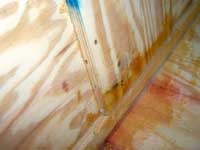 |
As you
can see, it’s a clean, strong joint.
|
|
After several days the GelMagic is hardened like
steel … well, maybe more like aluminum. It will
sand with effort and cuts with a jigsaw but is very
tough and difficult to cut with a utility knife. It
pays to work carefully, because spots that remain
and need to be taken off take some work - The wood
will give before the GelMagic.
| Oh, every
significant project requires a significant
helper. Mine is my four year old granddaughter,
Mattie (Maitlyn) who is learning to swim
and can’t wait to sail with me next
year! |

|
|
The bottom line is that I’ve just ordered a
second batch. I tried Gorilla Glue in just a couple
of non-critical places for comparison. There’s
no contest. The Gorilla Glue is runny and seems to
expand and sets up with air bubbles where it flows
out of a joint. I can’t speak about other adhesives,
of course, but I don’t see a need to use anything
else than GelMagic. This is hardly a professional
review but if you have questions I’ll try to
respond below.
Oh yes .. If you’ve been reading Duckworks
this year you realize that these parts are for my
15’ pocket cruiser Wanderer,
but some of you may be new to this great site, or
maybe just ‘Googled in “. You’ll
find the articles under “Designs” from
the main page. Since these shots the bottom is cut,
transom, bulkheads and stem glued in place, and the
stringers added. It’s beginning to look like
a boat.
Good boatbuilding .. Good sailing.
Bob Throne

|